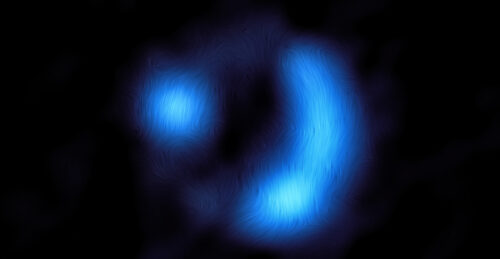Furthest ever detection of a galaxy's magnetic field

The ALMA image of the gravitationally lensed galaxy 9io9 with overlays indicating the presence of the magnetic fields. Credit: ALMA (ESO/NAOJ/NRAO)/J. Geach et al.
Using ALMA polarimetry data, a group led by Jim Geach at the University of Hertfordshire have measured the magnetic fields within the gravitationally lensed galaxy 9io9 at a redshift of 2.6. This is the most distant object in which magnetic fields have ever been measured. The presence of the magnetic fields along with its orientation parallel to the galaxy's molecular disc illustrates how such structures can form relatively early in cosmic history.
More information is available in the press release. The analysis has also been published in Nature, and the preprint is available from arXiv.
Registration for the 2024 European ALMA School is now open
The European ALMA Regional Centre network is organising an ALMA School for ALMA users that will be hosted by the UK ARC Node on 10-14 June 2024 in Manchester. This school is designed to provide training on a broad range of aspects related to ALMA, including interferometry, data calibration and imaging, the ALMA archive, analysis techniques, ALMA science, and future ALMA developments.
Registration for the meeting is now open at this link. Note that the meeting is in-person only and will be limited to approximately 80 - 90 participants. Registration will remain open until 31 December 2023, but people are advised to register early to avoid being placed on a waiting list.
For more details, please visit the meeting website. The full meeting details are currently being finalised, and the meeting website will be updated regularly with more information and announcements, including upcoming information on:
- Discounted block-booking hotel accommodation near the venue.
- A detailed agenda for the meeting.
- Warnings when the registration numbers begin to approach the meeting limit on participants.
- Detailed information on the venue and the city of Manchester.
UK ALMA 2024 Hybrid Workshop
19-21 February 2024
Alan Turing Building, The University of Manchester
Manchester, United Kingdom
This workshop will provide an introduction to ALMA and instructions on how to work with data from the observatory and will include sessions on preparing proposals, downloading data from the ALMA archive, calibrating and imaging ALMA data, and using advanced ALMA-related tools.
This workshop will be conducted in a hybrid format with participants having the option of either attending the workshop in person at the University of Manchester or joining online. More details will be provided later. While the workshop is aimed primarily at novice ALMA users, particularly from the United Kingdom, other users with higher levels of experience or from other locations are also welcome to attend.
To sign up, click on this link. Registration will close on 15 December 2023. For more information about the workshop, see the workshop's webpage.
Update to ALMA Helpdesk
The ALMA Helpdesk will be upgraded to Deskpro Horizon from 11 October to 13 October. During this time, the Helpdesk may not be available. Note that the appearance of the ALMA Helpdesk will not change for users. An announcement will soon be posted on the ESO ALMA page about this upgrade.

